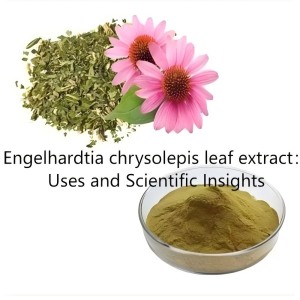Engelhardtia chrysolepis leaf extract:Uses and Scientific Insights

Engelhardtia chrysolepis leaf extract has gained attention in recent years for its potential health benefits and applications in both skincare and natural remedies. Known for its bioactive compounds, this botanical extract comes from the leaves of Engelhardtia chrysolepis, a plant native to parts of Asia. Researchers and product developers are beginning to explore its wide-ranging effects, from antioxidant properties to skin-soothing potential. This article offers an in-depth look into how this extract is used, what makes it effective, and why it’s gaining popularity in wellness circles.
What Is Engelhardtia chrysolepis Leaf Extract?
This extract is derived from the leaves of the Engelhardtia chrysolepis tree, commonly found in subtropical forests. Traditionally, the plant has been used in folk medicine, but modern extraction techniques now allow researchers to isolate specific components that offer therapeutic potential. The extract typically contains flavonoids, phenolic acids, and other bioactive molecules that contribute to its functional properties.
Bioactive Compounds and Health Benefits
Rich in Flavonoids
One of the standout features of this extract is its high flavonoid content, including quercetin and kaempferol derivatives. These compounds are known for their ability to neutralize free radicals, making the extract a strong candidate for antioxidant formulations.
Anti-inflammatory Effects
Research suggests that Engelhardtia chrysolepis leaf extract may help reduce inflammation by regulating pathways like COX-2 and NF-κB, which are involved in the body’s inflammatory response. This makes it potentially useful for conditions linked to chronic inflammation.
Potential Antibacterial Properties
Preliminary lab studies have shown that the extract can inhibit the growth of certain bacterial strains. While more clinical studies are needed, this could position it as a natural preservative or a topical agent in skincare products targeting acne and other bacterial skin issues.
Applications in Skincare and Cosmetics
Brightening and Skin Tone Balancing
Thanks to its antioxidant content, the extract may help reduce signs of oxidative stress on the skin, such as dullness and uneven pigmentation. It’s often included in brightening serums and creams for this reason.
Soothing Sensitive Skin
The anti-inflammatory elements also make it suitable for calming irritation and redness. Some formulations use the extract as an active ingredient in products meant for reactive or sensitive skin types.
Supporting Skin Barrier Function
Some compounds in the extract may help strengthen the skin’s natural barrier, improving hydration retention and overall resilience. This adds to its appeal for inclusion in daily skincare routines.
Formulation and Product Development
Water vs. Oil Extraction
The method of extraction affects the types of compounds retained. Water-based extracts are more hydrophilic and often used in toners or gels, while oil-based versions might be included in creams and balms for deeper penetration.
Stability and Preservation
One challenge in using natural extracts is maintaining stability in formulations. Engelhardtia chrysolepis extract is relatively stable under controlled conditions, but preservatives and packaging choices still play a critical role in product shelf life.
Combining with Other Actives
This extract pairs well with other natural ingredients like niacinamide, hyaluronic acid, and vitamin C. These combinations are often used to create multifunctional skincare solutions that offer hydration, brightening, and soothing effects all in one product.
Ongoing Research and Future Directions
While the current data is promising, more human clinical trials are needed to fully confirm the extract’s effectiveness and safety over long-term use. Scientists are also looking into its potential roles in metabolic health and even neuroprotection. As research expands, we can expect to see more targeted applications and refined extraction methods that make the most of this intriguing plant compound.


